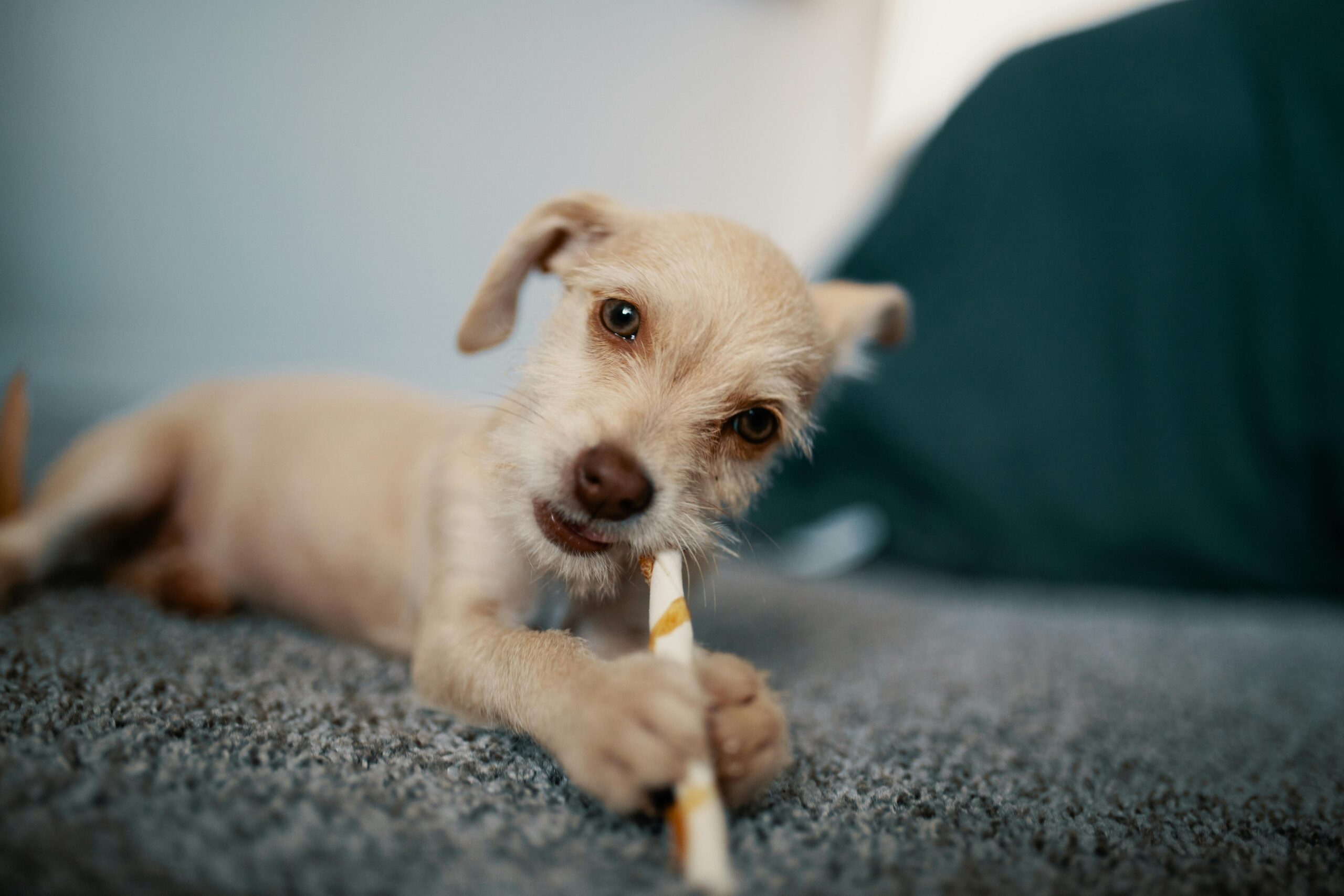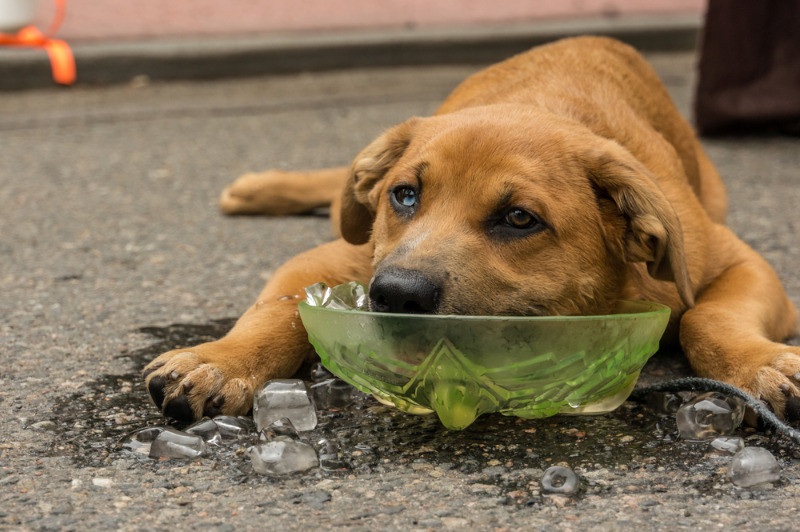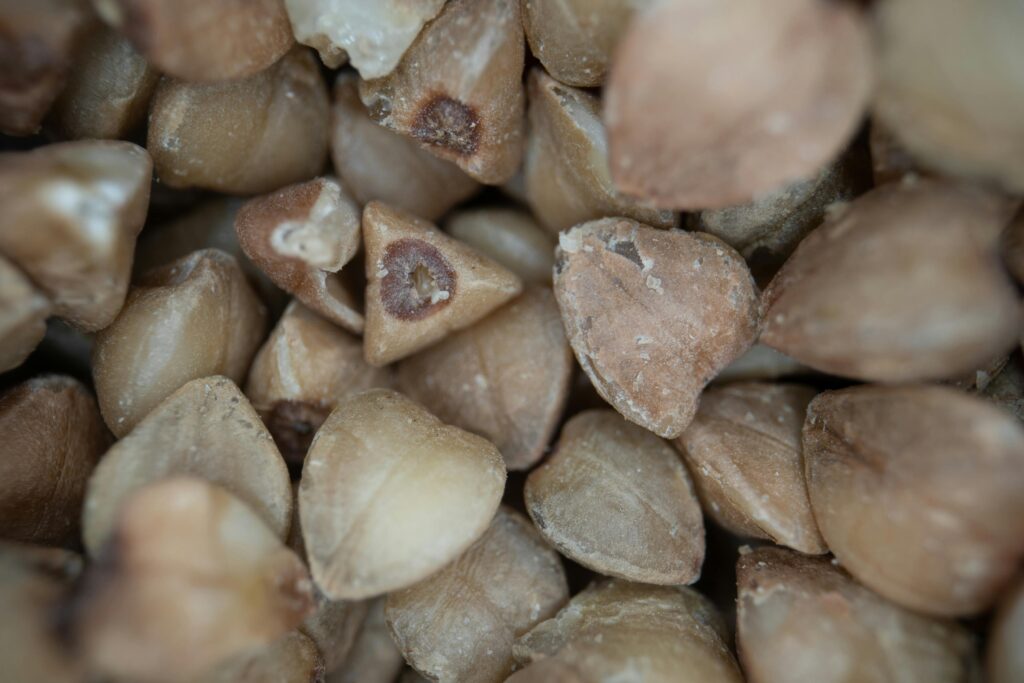Introduction to Puppy Chewing Habits
Puppies are adorable little bundles of energy, but along with the cuddles and wagging tails comes one common challenge: chewing. If you’ve ever had a puppy, you know exactly what this means—shoes torn apart, furniture legs gnawed down, and even unexpected bites on your hands when they’re playful. But here’s the thing: chewing isn’t just a naughty habit. It’s a completely natural and essential part of a puppy’s development.
Puppies chew for several reasons. First, it helps them explore their environment. Just like human babies who use their hands and mouths to learn, puppies discover the world through chewing. Second, chewing helps relieve discomfort when they are teething. Those sharp little teeth don’t come in without some pain, and chewing provides natural relief. Finally, chewing also keeps a puppy entertained and mentally stimulated. A bored puppy is a destructive puppy, and giving them the right chew options can save both your sanity and your furniture.
Think of chewing as a built-in survival tool. In the wild, chewing bones and sticks helped young dogs strengthen their jaws and clean their teeth. Today, even though your pup might have a comfy bed and a bowl full of food, the instinct to chew remains strong. The key is not to stop them from chewing but to guide them toward safe, healthy chew options that protect their tiny teeth and prevent accidents.
By understanding why puppies chew, you’re already taking the first step toward becoming a responsible dog parent. Instead of constantly saying “No!” and pulling things out of their mouths, you’ll be able to redirect that chewing behavior into something that benefits both you and your furry little companion.
Understanding Puppy Teething
Puppy teething is a big milestone, and every dog owner needs to understand what happens during this stage. Just like human babies, puppies lose their baby teeth and grow adult ones. This process can start as early as 3 weeks of age and usually continues until about 6 months.
The teething process comes with some very noticeable signs. Your puppy might drool more than usual, chew on everything in sight, or seem cranky and restless. Some pups may even eat less for a few days because their gums are sore. You may find tiny teeth on the floor or in their bedding—that’s completely normal and nothing to worry about.
Here’s a quick breakdown of the teething timeline:
- 2–4 weeks: Baby teeth (also called milk teeth) begin to appear.
- 5–6 weeks: Puppies usually have a full set of 28 baby teeth.
- 12–16 weeks: Baby teeth start falling out, and permanent teeth begin to grow.
- 6 months: Most puppies have a full set of 42 adult teeth.
During this time, chewing is more than just fun—it’s essential. It helps ease gum pain, encourages healthy tooth development, and prevents dental issues later in life. Giving your puppy safe chews during this stage is like giving a teething ring to a baby—it makes the process much easier and more comfortable.
But here’s the catch: not every chew is safe for teething puppies. Hard objects can break fragile baby teeth, while unsafe materials can cause choking or digestive problems. That’s why knowing the difference between safe and unsafe chews is critical for your pup’s health and happiness.
The Importance of Safe Chewing
Safe chewing isn’t just about saving your slippers—it’s about protecting your puppy’s health. When puppies chew on the wrong items, the consequences can be serious. Splintered sticks, for example, can puncture gums or even cause internal injuries if swallowed. Hard bones might seem like a natural option, but they can break tiny teeth or lead to painful fractures. And let’s not forget about store-bought chews with hidden dangers like toxic ingredients, sharp edges, or choking hazards.
The benefits of safe chewing, on the other hand, are endless. Safe chews promote dental health by helping reduce plaque and tartar buildup. They also satisfy your puppy’s natural urge to chew, which keeps them happy and calm. In addition, chewing stimulates the brain, fights boredom, and provides comfort during stressful times, such as crate training or being left alone for short periods.
Think of safe chewing as an investment. By choosing the right chew toys and treats now, you’re setting your puppy up for a lifetime of good habits. You’ll also avoid costly vet bills that come from emergency situations like swallowed objects or broken teeth.
So, the next time your puppy sinks their teeth into a chair leg, don’t just scold them. Instead, ask yourself: “Am I giving them safe and appropriate alternatives to chew on?” Because in the end, safe chewing isn’t just a training tool—it’s a form of love and care for your growing pup.
Types of Safe Chews for Puppies
Not all chews are created equal, and what works for one puppy may not work for another. Puppies come in all shapes, sizes, and chewing styles—some are gentle nibblers, while others are determined little “power chewers.” That’s why it’s important to know the different types of safe chews available and how to choose the right one for your pup.
- Natural Chews vs. Synthetic Chews
Natural chews, such as dried meat treats or vegetable-based options, are edible and often healthier. Synthetic chews, on the other hand, are designed to last longer and usually made from safe rubber or nylon. Both types have their pros and cons, so many owners keep a mix on hand. - Soft Chews for Sensitive Gums
Teething puppies need soft chews that won’t hurt their delicate gums. Plush chew toys, rubber toys with a bit of bounce, and softer edible chews are great for soothing sore mouths. - Frozen Chews for Teething Relief
A classic trick is to freeze a chew toy or even a wet washcloth. The cold helps numb sore gums and provides instant relief. Many puppy-safe rubber toys are designed to be stuffed with treats and frozen, making them both fun and soothing.
When choosing a chew, always consider your puppy’s age, size, and chewing strength. A small toy might be perfect for a Yorkie but could be a choking hazard for a Labrador puppy. The goal is to provide variety and keep things interesting, because just like us, puppies can get bored if they chew on the same thing every day.
What to Avoid in Puppy Chews
Here’s the part many new pet parents overlook: not everything sold as a “chew” is safe. In fact, the pet industry is full of products that can actually do more harm than good. That’s why being a smart shopper is crucial.
Dangerous Materials and Ingredients: Some chews are made with harmful chemicals, dyes, or preservatives that can upset a puppy’s stomach or worse, cause long-term health issues. Always check labels and stick to natural, vet-approved options.
Size and Shape Hazards: A chew that’s too small can easily get stuck in a puppy’s throat, creating a choking hazard. On the flip side, oversized chews can be frustrating and unusable. Choose chews appropriate to your puppy’s size and breed.
Toxic Substances to Watch Out For: Certain ingredients like xylitol, caffeine, or artificial sweeteners are extremely dangerous for dogs. Even some bones can be harmful, especially cooked ones, since they splinter easily.
The golden rule? If you wouldn’t give it to a teething baby, don’t give it to a puppy. Your furry friend relies on you to make the right choices, and knowing what to avoid is just as important as knowing what’s safe.
Best Natural Chew Options for Puppies
When it comes to choosing safe chews for puppies, natural options are often a favorite among dog owners and vets alike. Not only do they provide healthier alternatives, but they’re also gentler on tiny teeth and easier for growing pups to digest. The trick is knowing which natural chews are truly safe and which ones could pose hidden risks.
Carrots and Other Puppy-Friendly Vegetables
One of the simplest and safest chew options you can offer your puppy is a raw carrot. Carrots are firm enough to satisfy the chewing instinct but soft enough not to damage their fragile baby teeth. Plus, they’re low in calories and full of vitamins like beta-carotene, which supports eye health. You can even freeze a carrot before giving it to your pup—the cold texture helps soothe sore gums and provides extra chewing relief. Other safe vegetables include cucumber slices, zucchini sticks, and green beans. Always supervise your pup when they chew veggies to prevent choking.
Rawhide Alternatives
Traditional rawhide has been a go-to for years, but it can actually be dangerous for puppies. It swells in the stomach, can cause blockages, and often contains harmful chemicals. Thankfully, there are safer alternatives like compressed vegetable chews, collagen sticks, or specially made rawhide-free products. These are designed to be more digestible while still providing that satisfying chew texture.
Antlers and Bones: Are They Safe?
Many people think antlers and bones are natural and therefore safe, but the reality is a bit more complicated. While they might last a long time, they’re often too hard for puppy teeth and can lead to painful fractures. If you do want to try bones, stick to raw, soft bones specifically recommended for puppies, and never offer cooked bones since they splinter easily. For most puppies, it’s safer to skip bones and choose gentler natural chews instead.
Natural chews are excellent because they double as both a snack and an activity. They keep your pup busy, improve dental health, and provide extra nutrition. Just remember—every chew should match your puppy’s size and chewing style to prevent any accidents.
Vet-Recommended Commercial Chews
If you prefer store-bought options, there are plenty of vet-recommended chews designed specifically with puppies in mind. The challenge lies in picking the right ones from the endless rows at the pet store. The good news? Vets often recommend a handful of trusted brands that are known for safety, quality, and puppy-friendly features.
Popular Brands for Puppies
Some top-rated chew toy and treat brands for puppies include KONG Puppy, Nylabone Puppy Chews, Benebone Puppy Series, and Whimzees Natural Dental Chews. These are designed to be soft enough for developing teeth but tough enough to withstand enthusiastic chewing.
Features to Look for in Store-Bought Chews
When shopping, always look for products labeled specifically for puppies. These usually have softer textures and smaller sizes compared to adult versions. Check the packaging for safety certifications, natural ingredients, and a clear indication that the product is veterinarian-approved. Avoid products with vague labeling or long lists of artificial chemicals.
Comparing Prices vs. Quality
It’s tempting to grab the cheapest option, but when it comes to your pup’s health, quality matters more than price. A $2 chew toy that splinters and causes a vet visit could cost you hundreds in medical bills. Investing in higher-quality chews not only ensures safety but also tends to last longer, saving you money in the long run.
Commercial chews are an excellent option for busy pet parents who want reliable, ready-to-go choices. With a little research and vet guidance, you’ll find the perfect chew that keeps your puppy happy, healthy, and safe.
DIY Safe Chews at Home
Sometimes the best chews don’t come from the store at all—they come from your own kitchen. Making safe, DIY chews at home is a great way to save money while ensuring your pup gets natural, healthy chewing options.
Frozen Washcloth Trick
One of the simplest and most effective homemade chew toys is a frozen washcloth. All you need to do is soak a clean cloth in water, twist it into a rope-like shape, and freeze it. Once frozen, it becomes a perfect teething aid—cold enough to numb sore gums but soft enough not to cause damage. Puppies love the texture, and you’ll love how easy and inexpensive it is.
Homemade Puppy Treat Chews
Another great DIY option is baking soft chew treats at home. Using simple ingredients like pumpkin puree, oats, and peanut butter (make sure it’s xylitol-free), you can make chewable biscuits that are both tasty and safe. These not only satisfy your puppy’s chewing urge but also double as a healthy snack.
Safe Fruits and Veggies for Chewing
Alongside carrots, other fruits like apple slices (without seeds) or banana chunks can be offered as occasional chew snacks. Just make sure they’re cut into safe, manageable pieces. Freezing fruit slices can add an extra layer of soothing relief during teething.
DIY chews are especially helpful when you want complete control over what your pup is chewing. They’re cost-effective, safe, and customizable depending on your puppy’s needs. Plus, they’re a fun way to bond with your furry friend by making something special just for them.
Training Puppies with Chews
Chews aren’t just toys or snacks—they can also be powerful training tools. Puppies, by nature, don’t know the difference between what’s okay to chew (like a rubber toy) and what’s off-limits (like your shoes). That’s where chew training comes in.
Using Chews to Prevent Destructive Chewing
Every time you catch your puppy chewing something they shouldn’t, gently redirect them to a safe chew. Over time, they’ll learn what’s acceptable. The key is consistency. If you let them chew one pair of old shoes, they won’t understand why your new sneakers are off-limits.
Positive Reinforcement with Chew Toys
Whenever your puppy chooses the right chew toy on their own, reward them with praise or a small treat. This positive reinforcement builds good habits faster and makes your pup more likely to stick with the safe options.
Establishing Good Chewing Habits
Introduce chews during calm times, not just when they’re already being destructive. This helps create a routine and teaches your puppy that safe chews are not only acceptable but also enjoyable. Rotating toys every few days can also keep their interest high and prevent boredom.
Using chews as part of your training strategy is like teaching a child good manners—it takes patience, consistency, and encouragement. But once your puppy learns the rules, you’ll have a well-behaved companion who knows exactly what’s theirs to chew.
How to Introduce New Chews to Puppies
Introducing a new chew to your puppy might sound simple—just hand it over, right? Not quite. Puppies can be picky or even a little wary of unfamiliar textures and smells. Taking the right approach ensures that they not only accept the new chew but also enjoy it safely.
Supervised Introduction
Always supervise the first few times your puppy tries a new chew. Watch for any choking hazards, sharp edges, or aggressive chewing that might cause damage to their teeth. Supervision also helps you gauge whether your puppy likes the chew or not.
Monitoring for Allergies or Reactions
Just like people, puppies can have food sensitivities or allergies. If you’re introducing an edible chew, watch for signs of an upset stomach, excessive scratching, or unusual behavior. If anything seems off, discontinue the chew and consult your vet.
Rotating Chews for Engagement
Puppies can get bored quickly. Instead of giving them the same chew every day, rotate between different types to keep things exciting. This not only maintains their interest but also provides a variety of textures and benefits for dental health.
Introducing new chews the right way helps build trust and makes chewing a safe, enjoyable part of your puppy’s daily routine.
Safety Tips for Puppy Chewing
Chewing is natural and healthy, but it also comes with risks if you’re not careful. That’s why every responsible dog owner should follow a few essential safety guidelines when it comes to their pup’s chew time. By taking these simple precautions, you’ll keep your puppy safe while still letting them enjoy the benefits of chewing.
Supervision is Key
Never leave your puppy completely unsupervised with a new chew. Even products labeled “safe” can become dangerous if pieces break off or if your pup tries to swallow something too big. Always keep an eye out for choking, gagging, or unusual behavior while they chew. Once you’re confident a chew is safe for your specific puppy, you can allow short, monitored chew sessions while you’re nearby.
Replacing Worn Out Chews
Chews don’t last forever. As toys and edible chews wear down, they can break apart into small, sharp pieces that pose choking hazards. A good rule of thumb is to replace toys once they become too small to chew safely or if they develop cracks, sharp edges, or frayed parts. For edible chews, remove them once they get down to a swallowable size.
Choosing Age-Appropriate Chews
Puppies and adult dogs have very different chewing needs. Toys made for adult dogs may be too hard for puppy teeth and can lead to fractures. Always choose chews labeled specifically for puppies until your dog is about 6–8 months old and has their full set of adult teeth. After that, you can gradually introduce tougher options if your pup is ready.
The bottom line? Safe chewing requires attention. Think of it like giving a toddler a new toy—you wouldn’t hand it over and walk away. With the right safety measures in place, you’ll give your puppy hours of fun while protecting their teeth, gums, and digestive system.
Long-Term Chewing Benefits
Chewing isn’t just a puppy-phase activity. When supported with safe options, it becomes a lifelong habit that improves both physical and mental health. Let’s break down the long-term benefits your dog enjoys when you provide safe chews consistently.
Dental Health and Strong Teeth
Chewing helps scrape away plaque and tartar buildup naturally, reducing the risk of gum disease and tooth decay. It’s like a toothbrush your dog actually enjoys using. Puppies who learn to chew safely early on often have fewer dental issues as adults, saving you costly vet bills down the road.
Mental Stimulation and Stress Relief
Dogs of all ages need stimulation to stay happy and balanced. Chewing provides a calming, meditative activity that releases feel-good endorphins. This makes chews especially helpful during stressful times—like thunderstorms, fireworks, or when you leave the house.
Preventing Boredom and Anxiety
A bored puppy often becomes a destructive puppy. Chews keep them entertained and focused, reducing unwanted behaviors like chewing furniture, barking excessively, or digging. By providing consistent chewing outlets, you’re giving your dog a healthy way to release energy and frustration.
Long-term chewing isn’t just about teeth—it’s about overall well-being. Think of safe chews as part of your dog’s lifelong health plan, just like proper nutrition and exercise. When introduced correctly, safe chewing becomes a habit that supports a happy, well-adjusted pup well into adulthood.
Common Myths About Puppy Chewing
With so much information floating around, it’s easy to get confused about what’s safe and what isn’t. Let’s clear up some of the most common myths about puppy chewing.
“Hard Bones Are Always Safe”
Many people assume that bones are a natural and safe choice. While raw, soft bones can sometimes be okay under supervision, hard bones and antlers can easily break fragile puppy teeth. Cooked bones are even more dangerous, as they splinter and can cause internal injuries.
“Puppies Will Outgrow Chewing”
Yes, chewing intensity often decreases as puppies mature, but dogs never completely stop chewing. It’s a lifelong behavior that provides comfort, stimulation, and dental health. If you don’t establish good habits early on, you’ll deal with destructive chewing long into adulthood.
“All Toys Marketed for Puppies Are Safe”
Unfortunately, not everything on the pet store shelf is truly safe. Some cheap toys can break apart easily, contain harmful dyes, or pose choking hazards. Just because it’s labeled “puppy toy” doesn’t automatically mean it’s safe—always do your research.
By separating myths from facts, you’ll make smarter decisions for your pup. Safe chewing isn’t about following old advice—it’s about using up-to-date knowledge and vet-backed recommendations to protect your furry friend.
Frequently Asked Questions
1. How many chews should a puppy have daily?
It depends on your puppy’s age and energy level. Generally, one or two safe chews per day is plenty. Too many edible chews can upset their stomach, so balance is key.
2. Are raw bones safe for puppies?
Raw bones can be risky. While some vets may approve soft, raw bones under supervision, many advise against them for puppies due to the risk of fractures and digestive blockages. Safer alternatives include rubber puppy toys or edible chews designed for young dogs.
3. Can puppies chew on sticks?
It’s best to avoid it. Sticks can splinter, leading to mouth injuries or internal damage if swallowed. Instead, provide rubber toys shaped like sticks or natural alternatives such as frozen carrots.
4. What’s the best chew for aggressive chewers?
For strong chewers, durable puppy-safe toys like KONG Puppy, Benebone Puppy Series, or Nylabone teething toys are great choices. Just be sure they’re designed for puppies and not too hard for developing teeth.
5. Should I let my puppy chew unsupervised?
No. Puppies should never be left completely unsupervised with chews. Even safe toys can become dangerous if pieces break off or if they attempt to swallow something too large. Always supervise until you’re confident it’s safe.
Conclusion
Chewing is more than just a phase—it’s a natural, necessary part of your puppy’s growth and development. By offering safe chew options, you’re not only protecting their tiny teeth but also teaching them healthy habits that last a lifetime. From natural chews like carrots to vet-approved toys and DIY frozen washcloths, the key is variety, supervision, and age-appropriate choices.
Remember: unsafe chews can lead to injuries, expensive vet visits, and lifelong dental problems. But the right chews? They provide comfort, entertainment, mental stimulation, and a healthier smile for years to come.
So next time your puppy sinks their teeth into your slipper, don’t just panic—redirect them to a safe chew and let them enjoy the process. Tiny teeth deserve big care, and with the right approach, you’ll raise a happy, healthy, and well-adjusted pup.
Please don’t forget to leave a review.




